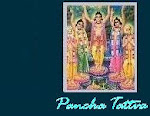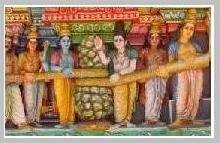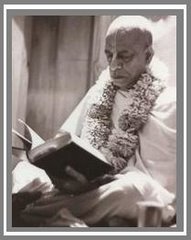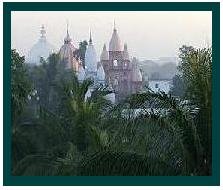
The light of one candle being communicated to other candles, although it burns separately in them, is the same in its quality. I adore the primeval Lord Govinda who exhibits Himself equally in the same mobile manner in His various manifestations.
PURPORT
The presiding Deities of Hari-dhama, viz., Hari, Narayana, Visnu, etc., the subjective portions of Krsna, are being described.
The majestic manifestation of Krsna is Narayana, Lord of Vaikuntha, whose subjective portion is Karanodakasayi Visnu, the prime cause, whose portion is Garbhodakasayi.
Ksirodakasayi is again the subjective portion of Garbhodakasayi Visnu.
The word "Visnu" indicates all-pervading, omnipresent and omniscient personality.
In this sloka the activities of the subjective portions of the Divinity are enunciated by the specification of the nature of Ksirodakasayi Visnu. The personality of Visnu, the embodied form of the manifestive quality (sattva-guna) is quite distinct from that of Sambhu who is adulterated with mundane qualities.
Visnu's subjective personality is on a level with that of Govinda. Both consist of the unadulterated substantive principle. Visnu in the form of the manifest causal principle is identical with Govinda as regards quality. The manifestive quality (sattva-guna) that is found to exist in the triple mundane quality, is an adulterated entity. being alloyed with the qualities of mundane activity and inertia.
Brahma is the dislocated portion of the Divinity. manifested in the principle of mundane action, endowed with the functional nature of His subjective portion; and Sambhu is the dislocated portion of the Divinity manifested in the principle of mundane inertia possessing similarly the functional nature of His subjective portion.
The reason for their being dislocated portions is that the two principles of mundane action and inertia being altogether wanting in the spiritual essence any entities, that are manifested in them, are located at a great distance from the Divinity Himself or His facsimiles.
Although the mundane manifestive quality is of the adulterated kind, Visnu, the manifestation of the Divinity in the mundane manifestive quality. makes His appearance in the unadulterated manifestive principle which is a constituent of the mundane manifestive quality. Hence Visnu is the full subjective portion and belongs to the category of the superior isvaras. He is the Lord of the deluding potency and not alloyed with her. Visnu is the agent of Govinda's own subjective nature in the form of the prime cause. All the majestic attributes of Govinda, aggregating sixty in number, are fully present in His majestic manifestation, Narayana. Brahma and Siva are entities adulterated with mundane qualities. Though Visnu is also divine appearance in mundane quality (guna-avatara), still He is not adulterated.
The appearance of Narayana in the form of Maha-Visnu, the appearance of Maha-Visnu in the form of Garbhodakasayi and the appearance of Visnu in the form of Ksirodakasayi, are examples of the ubiquitous function of the Divinity. Visnu is Godhead Himself, and the two other guna-avataras and all the other gods are entities possessing authority in subordination to Him.
From the subjective majestic manifestation of the supreme self-luminous Govinda emanate Karanodakasayi, Garbhodakasayi, Ksirodakasayi and all other derivative subjective divine descents (avataras) such as Rama, etc., analogous to communicated light appearing in different candles, shining by the operation of the spiritual potency of Govinda.



















